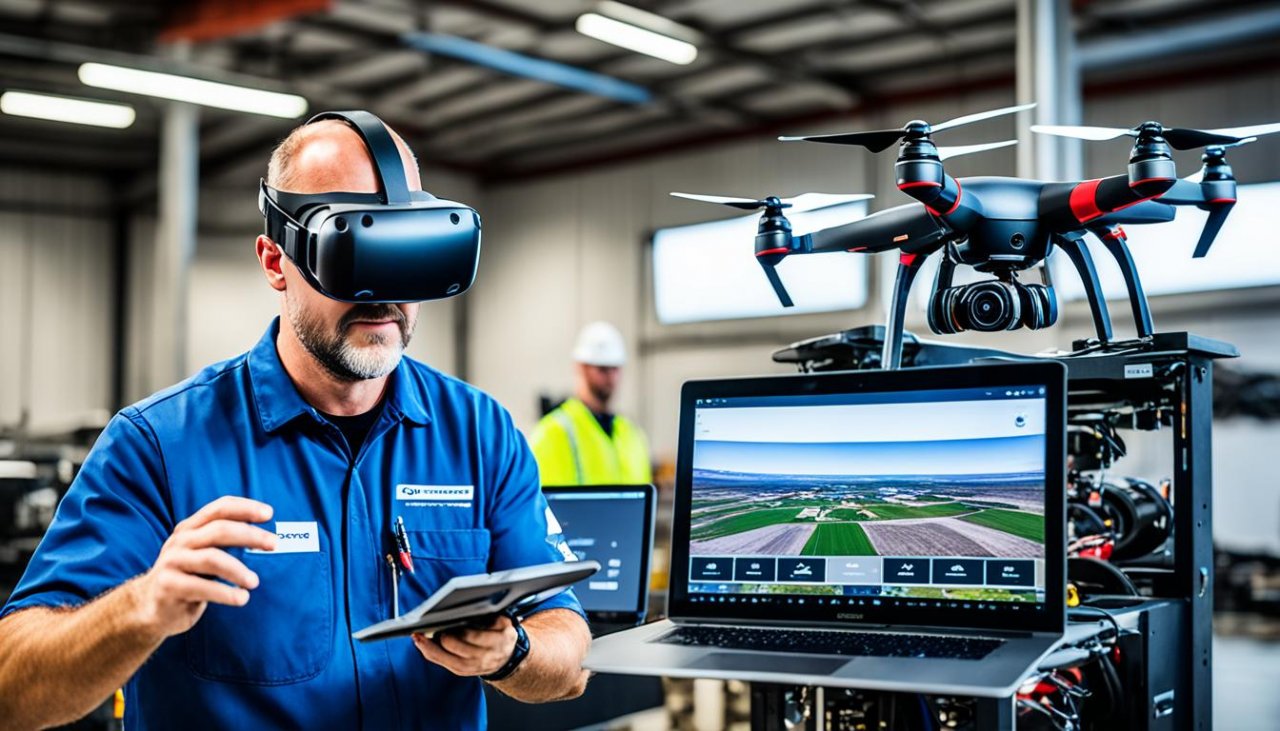What’s next for field service management? Is it just fixing today’s problems quickly? Or should we look ahead with a new approach? The field service world is changing fast. To move forward, companies need to use new, green tech and big ideas.
To change field service for the better, we need to think long-term. It’s not just about quick fixes. It’s about dreaming big and picking the right tools to lead the way. With a vision-first strategy, companies can set goals, choose where to spend, and do research that keeps them innovative.
Key upgrades we’ll see are in predictive maintenance and digital twins. These changes show us a sneak peek of what’s possible in the future. They also help companies run their services better.

Key Takeaways:
- Predictive maintenance and digital twin technology are shaping the future of field service management.
- A futurist approach is essential for defining priorities and investing in the right technologies.
- Short-term thinking traps companies in a cycle of tactical responses, hindering long-term growth.
- Sustainable innovations offer a preview of how the field service industry may evolve.
- The future of field service management is driven by transformative technologies and a clear vision.
Predictive Maintenance
The predictive maintenance market is growing fast. By 2030, it’s expected to jump by nearly 30% every year. This surge is partly due to companies wanting to cut downtime and costs.
This method lets companies predict when machines might fail. It uses data and machine learning. So, they can fix things before they break, saving time and money.
Updating to predictive maintenance boosts how well a business runs. It keeps customers happy by stopping equipment troubles before they start. This way, companies keep running smoothly, pleasing everyone.
Remote Monitoring for Predictive Maintenance
Remote monitoring is crucial for predictive maintenance. It lets companies check on their gear from afar, using real-time data. This info helps predict possible issues using smart software.
With remote monitoring, experts don’t always need to be on-site. They can keep an eye on machines from anywhere. This not only saves time but also makes maintenance work safer and more efficient.
This high-tech approach lets businesses stay ahead. They can tweak their systems to work even better. By combining predictive maintenance with remote checks, they gain big benefits, like saving money and keeping customers happy.

Digital Twin
The digital twin market is expected to grow quickly from 2021 to 2026. Much of this growth will happen in North America, in fields like cars and planes. This tech makes a digital copy of real systems using AI, machine learning, and IoT.
This lets businesses see real-time data about their stuff and processes. It’s used a lot in the service industry to watch over and make things better. For example, it’s used in software that keeps track of how well machines are working.
Digital twins can catch problems early, before they get big. They make a digital version of machines or equipment. This way, companies can test different situations without touching their real stuff. It helps them work better and save money.
Real-time Monitoring and Predictive Maintenance
Digital twins let companies watch their real things all the time. They can see when something is about to go wrong. This helps do maintenance work right when it’s needed, not too early or too late.
Predictive analytics can also use older data to guess what might happen next with a machine. This guessing game is really good for planning maintenance. It stops machines from breaking when they’re needed the most.
Companies can also play with their digital models to see what works best. They can tweak settings to find the perfect way these machines should run. It makes them faster, cheaper to run, and last longer.
The Role of IoT and AI in Digital Twin Technology
The Internet of Things (IoT) links real things to digital copies. This lets companies keep an eye on their stuff all the time. They use AI to make sense of the data these digital twins collect.
This means smart computer programs can find hidden problems and solutions. They make these digital twins even more useful. Now, companies can do the best for their equipment and make their customers happier.
AR and VR for Remote Assistance
Augmented reality (AR) and virtual reality (VR) are changing the field service game. They offer remote help that lets technicians spot and solve problems before they occur. They also allow technicians to work with remote experts instantly, getting help and advice as needed.
Microsoft’s Hololens is a big step forward in this remote help. It lets technicians add digital info to what they are seeing. With AR and VR, companies can make their services better, making both the work smoother and the customers happier.
Visualizing Simulated Environments
AR and VR let technicians step into a digital copy of a real-world job. This deep dive lets them really understand the job and any challenges it might have. By seeing these digital worlds, they can prevent problems before they show up, keeping the job running smoothly.
Connecting with Remote Experts
AR and VR also bring technicians together with faraway experts. Through live video and instant messaging, they can talk and solve problems together. This way, experts don’t have to fly in, saving time and money.
Using these new technologies, technicians get the help they need to do an amazing job. This is just the start of a new era in service, where help is always close, no matter how far away it seems.
Dynamic Scheduling and Dispatch
Field service operations work best with smart schedules and dispatching. McKinsey notes that watching technicians’ schedules in real-time can give 20 to 30% more work in a day. This shows how powerful good scheduling is for making better use of resources.
For better dispatch, companies look at many things. They see if the technician has the right skills and is close by. They also check the job’s urgency and if it fits the right budget. This way, they send the best person for the job, saving time and costs.
Using tech for scheduling and dispatching can make managing field services much better. It helps assign resources smoother, cutting down on mistakes and time to react. This helps a lot when there are sudden changes or emergency jobs. It keeps customers happy by solving issues quickly.
Workforce Optimization
Dynamic scheduling and dispatch make the best use of everyone’s time and skills. By looking at who’s free, nearby, and skilled for a job, companies work smarter. This means less wasted time, lower costs to get there, and more work done by field technicians.
Doing this not only helps the companies but makes customers happier too. With dispatch optimized, companies can handle requests faster and on time. This improves customer happiness and loyalty.
For businesses that want to lead in field services, smart scheduling and dispatch are key. Using technology and data helps with better decisions. It makes resources go further, boosts earnings, and helps stand out in the market.

Route Optimization
Route optimization is vital for efficient field service management. It uses GIS technology to find the best routes. This saves time and fuel. The market for this technology is growing fast, showing its importance.
Route optimization software finds the best routes using powerful engines. It recommends the most cost-saving and efficient ways to deliver service. Users can pick fuel-efficient paths, avoiding unplanned stops. This makes the work more productive and reduces waiting time.
GIS technology offers field teams updates in real-time. It provides accurate maps and detailed data. This helps them plan better routes considering traffic, customer locations, and work constraints.
Using route optimization software improves how companies work in many ways. Technicians reach places faster with better routes. This makes them offer quick, reliable service, leading to happier customers and a better company reputation.
To show how important route optimization is, think about this example:
Example Scenario:
ABC Field Services used route optimization software to better their work. Thanks to GIS, technicians got the best routes for each job. This saved a lot of time and money. ABC Field Services saw better efficiency, less fuel use, and happier customers.
In summary, route optimization using GIS is key for field service management. It cuts fuel costs and boosts efficiency. With route optimization software, companies can achieve more, save money, and make customers happier.
Customer Self-service Portals
The market for customer self-service solutions is growing fast. It’s expected to jump from $12.9 billion in 2022 to $34.35 billion by 2027. Businesses are turning to self-service portals and apps to meet customer expectations better. These tools improve customer experiences and increase engagement.
Self-service portals give customers access to useful tools. They can set up technician visits, find service locations, and give feedback. This puts customers in charge of their own service experiences.
These portals also help create communities around products and services. Customers can swap stories, share advice, and make recommendations. This community part boosts brand loyalty and customer happiness. It creates feelings of trust and belonging among customers.
Today, customers like using self-service portals on websites more than other support options. They are found to be easier and more convenient. These portals offer quick access to important information. They allow customers to make appointments and communicate with the service provider easily. The simple layouts and easy-to-use systems of these portals save customers time and trouble.
Workforce as a Service
The gig economy has changed the field service industry. It’s estimated that 68 million freelance technicians and contractors work in the US. This shift is transforming how companies manage their workforce.
To keep up, companies are using advanced systems to manage work orders. These systems help businesses understand and prevent potential issues, boosting efficiency and cutting down on service problems.
Workforce management platforms are key. They give freelancers the info they need securely. And they help in-house and freelance workers work well together, leading to better use of resources and enhanced service.
By joining the gig economy, businesses can find skilled freelancers easily. This flexibility lets them adjust their workforce as needed. This way, they save on full-time staff costs.
Conclusion
The field service management industry is changing a lot. This change is driven by new technology. Things like predictive maintenance, digital twin, and AR are making big differences. They help manage tasks, plan routes better, and offer new self-service options for customers.
These innovations can really transform how businesses operate. They bring chances to work smarter, save money, and make customers happier. It’s important for companies to start using these new tools today to do well in the future.
Mobile apps are key for field technicians. They help them find info quickly, talk easily, and make better use of resources. To keep up with changing times, businesses must use these apps. This way, they can be better than their competitors and meet what customers want.
By using new trends and mobile tools, companies are ready for the future. Technology will keep changing how field services work. This creates more ways to grow and succeed.
See how FieldAx can transform your Field Operations.
Try it today! Book Demo
You are one click away from your customized FieldAx Demo!
FAQ
What is predictive maintenance?
Predictive maintenance is a smart strategy using data and machine learning to predict when equipment might fail. It finds unusual patterns and estimates how much longer the equipment should last. This method helps businesses cut down on stopping times, save money, and make their work better for both them and their customers.
What is digital twin technology?
Digital twin technology creates a virtual copy of physical things like machines or buildings using AI and IoT. This virtual copy can gather real-time data and offer insights for better performance. In the service industry, they use this tech to keep an eye on and improve how different systems work.
How does AR and VR assist remote assistance in field service?
AR and VR create digital worlds where service techs can spot and understand issues before they really happen. They also make it possible for techs in the field to easily talk to experts far away. This makes fixing problems more of a team effort and often solves them faster.
How does dynamic scheduling and dispatch optimize field service management?
Dynamic scheduling looks at techs’ skills, how close they are to a job, and how important a job is. It helps assign techs to jobs in smart ways. By doing this automatically, businesses save money, work more efficiently, and keep their customers happy.
How does route optimization benefit field service management?
Route optimization uses tech to find the fastest and cheapest ways for techs to get to their jobs. It saves on fuel and time, making services run more smoothly. This leads to a more productive business overall.
What are customer self-service portals in field service management?
These portals are like special websites or apps for clients that help do things themselves. Clients can schedule when techs come, find where they are, and give feedback, all without contacting the company directly. They give clients more power over their service and help the company connect better with its community.
How does the gig economy impact the field service industry?
The gig economy brings in more independent freelancers for service jobs. By keeping track of work using special systems, companies can easily manage their freelance teams. They are better prepared for problems and can regulate their staff more effectively.
What are the key trends in field service management?
Important trends include using data to predict when maintenance is needed, making digital copies of real systems, and finding ways to fix issues remotely using AR and VR. Also, scheduling techs’ work cleverly, planning smart routes, giving clients websites to help themselves, and rethinking how workers are hired. All these new ideas and tech aim to make work smoother, cheaper, and better for everyone involved.
How can companies thrive in the evolving field service industry?
Staying on top means using new tech and ideas, always growing, and being able to change with the times. This way, companies can beat their rivals and provide top-notch service. It’s all about being innovative and willing to try new things to keep getting better.
Author Bio
Co-Founder & CMO at Merfantz Technologies Pvt Ltd | Marketing Manager for FieldAx Field Service Software | Salesforce All-Star Ranger and Community Contributor | Salesforce Content Creation for Knowledge Sharing






